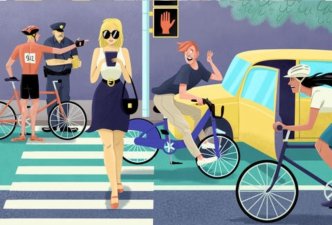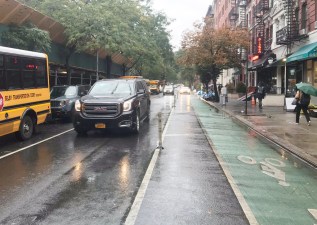The Real Reason Uber Traffic Matters in NYC

For a moment yesterday, it seemed like the big clash between the taxi medallion industry and app-based car services, framed in terms of Uber’s effect on snarled Manhattan traffic, might veer into unexpectedly brilliant territory. There was Deputy Mayor Anthony Shorris in the Daily News, telling the MTA that City Hall would consider the Move NY traffic reduction plan to fund transit investment. Finally, a sign that some of the big players are getting serious about a comprehensive fix for the city’s congestion problem.
But the moment didn’t last long, with Governor Cuomo extinguishing the road pricing talk right away. Soon after, Mayor de Blasio beat a sudden retreat from his proposed cap on for-hire vehicle licenses, getting a few concessions from Uber, and now the whole episode will fade from the news cycle, at least for the time being.
The Uber fight was a rare case where transportation issues became front-page news, but the arguments about streets and traffic tended to descend into stupid talking points really fast. Uber NYC General Manager Josh Mohrer was hardly the only person who tried to blame bike lanes and other safety measures for the recent downturn in average Manhattan traffic speeds. Council Member Dan Garodnick, someone who generally gets how streets work and chooses his words carefully, was the first public figure on record to toss around that theory.
When you’re talking about the downsides of congestion, it’s tough to avoid framing the problem like an old-school traffic engineer, placing paramount importance on the movement of cars. Even on Streetsblog, we’ve run plenty of posts talking about the effect of Uber in terms of average traffic speeds. The trouble is that when you focus on how easily people can drive around the city, you create an opening for people to point their finger at anything that might slow down cars — like bike lanes, or a lower speed limit.
You can try to reason with these people and explain the difference between peak speed and average speed, or show the data about bike lane redesigns that had no discernible effect on traffic. And that might win some arguments. But if you want streets where bus riders have swift trips, where people of all ages feel safe walking and biking, you’re going to have to make some changes that — at least for a while, before a new equilibrium sets in — slow down cars.
We need to come at the problem from a different angle. So how about this: Traffic congestion in New York is terrible because it’s an obstacle to designing streets that work best for our city.
For readers who are new to Streetsblog, I’m talking about dedicated lanes for transit on avenues and major crosstown streets, so 60 people riding a bus don’t stew in traffic behind a few people in Suburbans. An extensive grid of protected bikeways on wide streets, so fear of speeding traffic doesn’t keep people from getting around on a bicycle. Pedestrian zones and generous sidewalks that don’t compel people to squeeze by each other and weave into the roadway for blocks at a time when things get too crowded.
A citywide curb-to-curb overhaul like this would do wonders. If you could snap your fingers and make it happen tomorrow, we’d have streets that are tremendously more productive, efficient, equitable, safe, and sociable than they are today. Way more people could get where they’re going, faster; way fewer people would get hurt or killed on the streets; and generally speaking we’d be in a much better mood.
But imagine the honking that first week! There might be riots during the adjustment period. Then, eventually, a lot of people accustomed to driving would figure out better ways to get around, and congestion would return to the same level as before.
Traffic congestion, in this sense, is a political problem. Where congestion is worse, the adjustment to a street redesign is more wrenching and the political cost is higher. Congestion makes City Hall more hesitant and DOT more timid when it comes to implementing things like bus lanes and Vision Zero projects.
I’m not saying that congestion is a valid excuse to do nothing, or to water down a project, but there’s no escaping the fact that it makes change harder. And it’s getting worse in Manhattan.
Ideally, New York would deal with its congestion problems through a better system of pricing for roads and parking than the jumble of traffic-inducing free bridges and cheap curb space we have today. This would free up street space to be more easily repurposed for transit, walking, and biking. With a good system, even on streets without transit lanes, buses would travel much faster. So would commercial traffic, which is much more important to the city than private car trips.
A well-designed system would have a specific price structure for taxi and livery trips, which contribute hugely to Manhattan congestion because of the intense incentive to pick up fares in the most crowded parts of town. This could be doubly beneficial, making for-hire vehicles more readily available in neighborhoods where transit service is not so copious.
That’s the ideal, anyway. But New York City can’t enact road pricing if the governor won’t let it happen, and so far Andrew Cuomo is implacably opposed. (De Blasio and his DOT could do a good chunk of the parking piece on their own, but that’s a separate post.)
What options does that leave City Hall right now? A citywide “Uber cap,” as proposed, is a blunt instrument — too blunt! Still, as Charles Komanoff has shown, the justification for it is rooted in the very real observation that Uber traffic is a major factor in the recent intensification of Manhattan congestion.
This is a problem for the de Blasio administration, and not just because the mayor got a lot of medallion money during his campaign. City Hall has laid out goals for street safety and bus improvements that will require shifting significant amounts of street space away from cars. If Uber traffic continues to grow at its current rate, that’s going to be an obstacle to Vision Zero and great bus service in the city core.
While an Uber cap for the congested heart of the city makes sense, limiting app-based car services outside the core is a different story. In places without good transit, services like Uber can fill gaps in the bus and subway network and make it easier to forgo owning a car. At the Awl, Matt Buchanan suggested a simple tweak to a citywide ceiling on for-hire vehicle licenses: capping app-based pick-ups in the center city, while leaving the rest of the five boroughs alone. Uber GM Mohrer called it “an example of a creative solution I would love to have with City Hall.”
We’ll see if that idea gets traction. The issue isn’t going away, and when City Hall’s study of the for-hire vehicle industry wraps up in a few months, we’ll get to argue about it all again. The next time around, let’s have a smarter debate.

